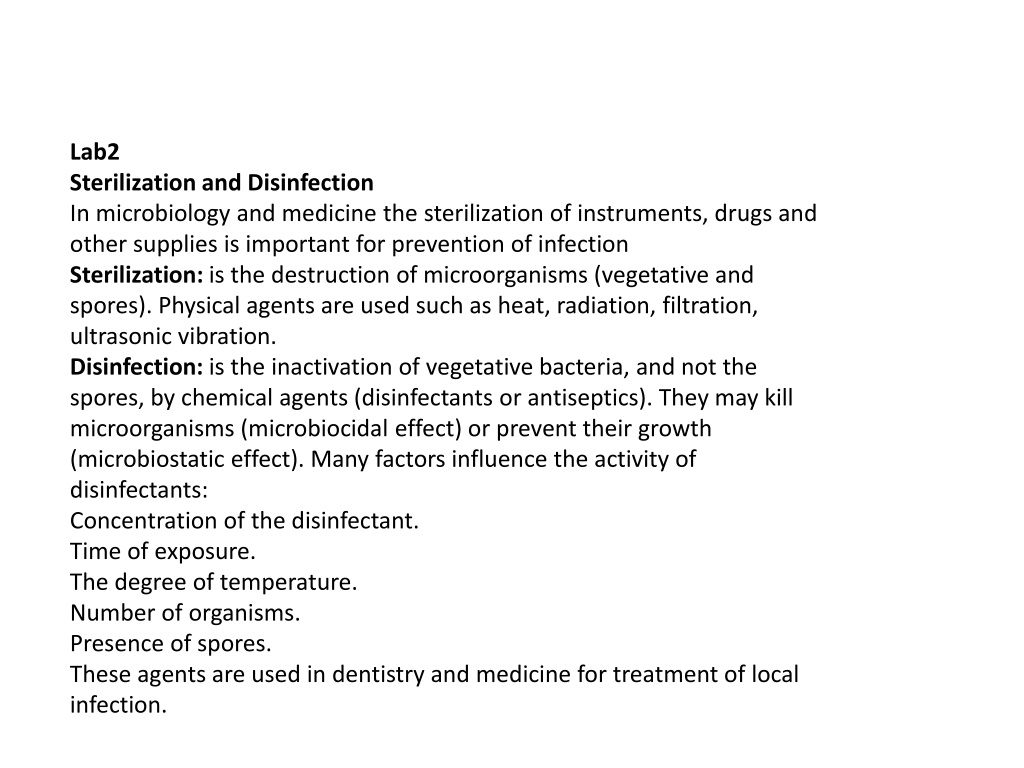Sterilization and Disinfection in Microbiology and Medicine: Importance and Methods
Sterilization and disinfection are crucial in preventing infections in microbiology and medicine. Sterilization involves the destruction of microorganisms, while disinfection targets vegetative bacteria using chemical agents. Factors affecting disinfectant activity include concentration, time of exposure, temperature, and more. Infection control in dentistry is important to prevent transmission of pathogens between patients and dental health care personnel. Various methods like heat, filtration, and radiation are used for sterilization. Proper procedures like flaming and use of ethanol are essential for infection control in dentistry.
Download Presentation

Please find below an Image/Link to download the presentation.
The content on the website is provided AS IS for your information and personal use only. It may not be sold, licensed, or shared on other websites without obtaining consent from the author. Download presentation by click this link. If you encounter any issues during the download, it is possible that the publisher has removed the file from their server.
E N D
Presentation Transcript
Lab2 Sterilization and Disinfection In microbiology and medicine the sterilization of instruments, drugs and other supplies is important for prevention of infection Sterilization: is the destruction of microorganisms (vegetative and spores). Physical agents are used such as heat, radiation, filtration, ultrasonic vibration. Disinfection: is the inactivation of vegetative bacteria, and not the spores, by chemical agents (disinfectants or antiseptics). They may kill microorganisms (microbiocidal effect) or prevent their growth (microbiostatic effect). Many factors influence the activity of disinfectants: Concentration of the disinfectant. Time of exposure. The degree of temperature. Number of organisms. Presence of spores. These agents are used in dentistry and medicine for treatment of local infection.
Why is Infection Control Important in Dentistry? Both patients and dental health care personnel (DHCP) can be exposed to pathogens. Contact with blood, oral and a respiratory secretion, mucosa of the eyes, nose, and contaminated equipment occurs. Proper procedures can prevent transmission of infections among patients and DHCP. 1-Physical method: A- Heat B- Filtration C- Radiation Heating: Kills microorganisms by denaturing their enzymes and other proteins. Thermal Death Point (TDP): Lowest temperature at which all of the microbes in a liquid suspension will be killed in ten minutes. Thermal Death Time (TDT): Minimal length of time in which all bacteria will be killed at a given temperature. Heat can be divided to: A-Heat a-Dry heat a1-Direct flaming: for inoculating loops and needles forceps and spreaders, and the open end of culture tubes, flasks and bottles. (fig.2)
Procedure: For inoculating loops and needles. 1- Flame the inoculating loop or needle over a Bunsen burner until the wire becomes red hot. 2- Cool the hot loop. 3- Use the loop or needle before it becomes contaminated. forceps and spreaders. 1- Dip the points of forceps or the L-shaped glass rod spreader into a beaker of 70% ethanol. 2- Pass the ethanol-soaked forceps or spreader through the flame to burn off the alcohol .Allow it to cool. 3- Use the forceps or spreader before it becomes contaminated.
a2 Hot air :( by oven) This method is used by exposure at temperature 160 to 170 for two hours. This way is used for sterilization of glassware, such as glass petridishes, test tubes, pipettes, flasks et.c. Procedure: Set the electric oven to operate between 160 and 170 c. Place the clean glassware inside the oven for 2 hours. Note: pipettes and petridishes are placed inside special cans or folded with foil paper, test tubes, flasks and other containers must be closed with cover or cotton plugs before they are placed in the oven.
b) Moist heat: Kills microorganisms by coagulating their proteins. - In general, moist heat is much more effective than dry heat. b1-Sterilization at a temp. Below 100 co : This method is used to sterilize serum, body fluid containing coagulable proteins. Temperature of 56 Co for 1hr. used to sterilize vaccines in special water bath. Pasteurization: This method discovered by Louis Pasteur to use for preservation of milk and fruit juices. -Classic Method of Pasteurization: Milk was exposed to 63 -66 c for 30 minutes. -High Temperature Short Time Pasteurization (HTST): Milk is exposed to 71-72 c or 15 minutes - Ultra High Temperature Pasteurization (UHT): Milk is treated at 140 c for 3 seconds and then cooled very quickly in a vacuum chamber.
Advantage: Milk can be stored at room temperature for several months. This method will destroy non spore forming pathogenic bacteria. This way will kill all the non-spore forming pathogens such as Mycobacterium tuberculosis, Brucella abortus and various types of Salmonella Procedure: 1- Set the water bath at required temperature. 2- Put the materials that to be preserved in the water bath for the required time. b2- temperature 100 c for 10 minutes. This is sufficient to kill all non-spore-forming. It is used for dental and medical instruments such as syringes, needles, sutures and others Tyndalization: is the method that used for the removing of spores. This method involves steaming for 30 minutes on each time, for three successive days. Procedure: (for tyndalization) 1- Prepare broth culture of spore forming bacteria. 2- Prepare water bath (100 c). 3- Put the broth culture in the water bath for 30 minutes. 4- Put the treated broth culture in the incubator, to allow spores to germinate and vegetative bacteria to grow. 5- Examine the presence of the vegetative bacteria by inoculating of loobful broth culture on the nutrient agar surface. 6- Repeat these steps for three times. b3 Heating more than 100 c under pressure
























